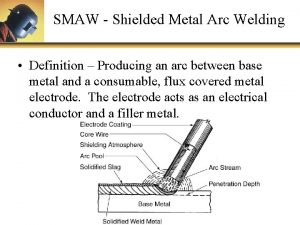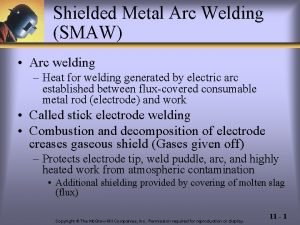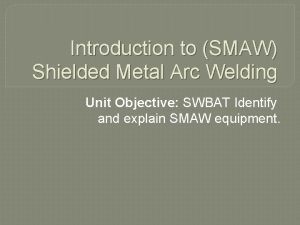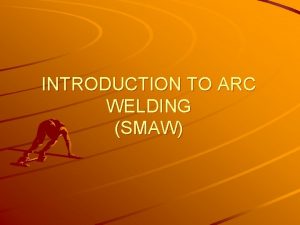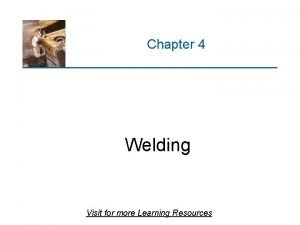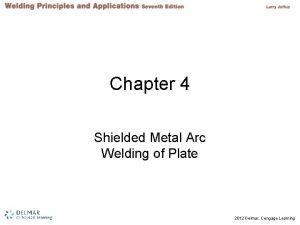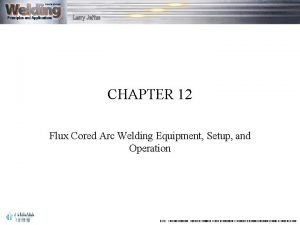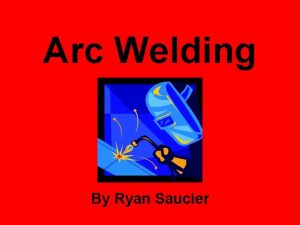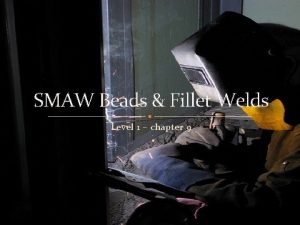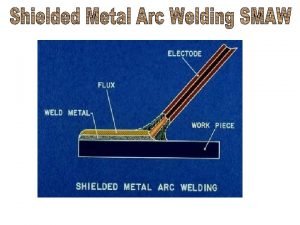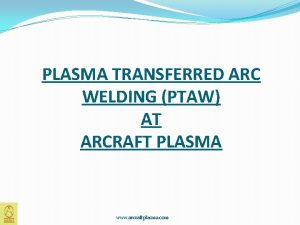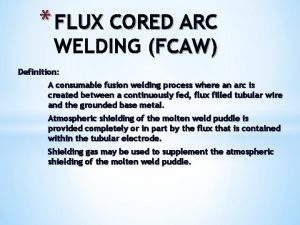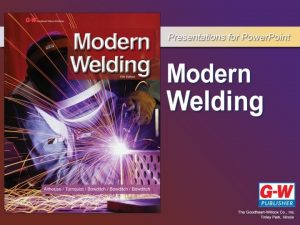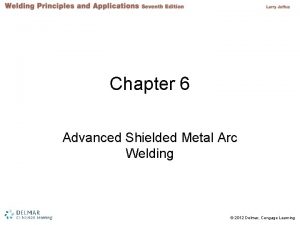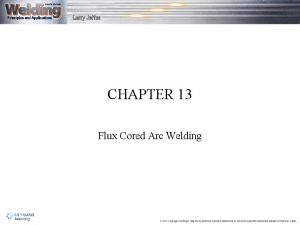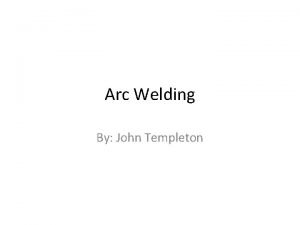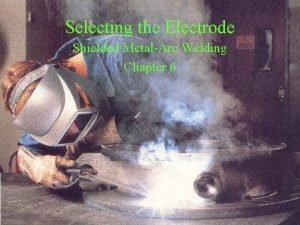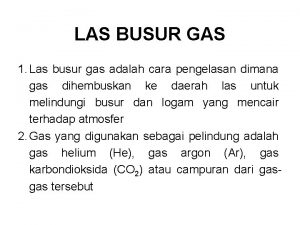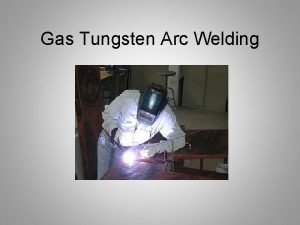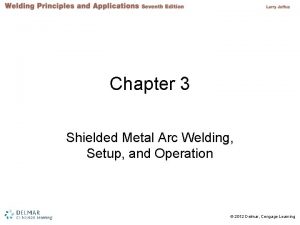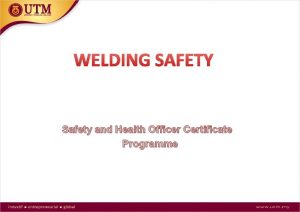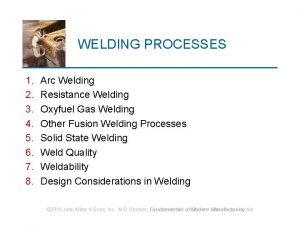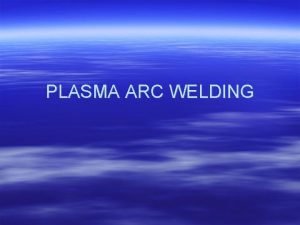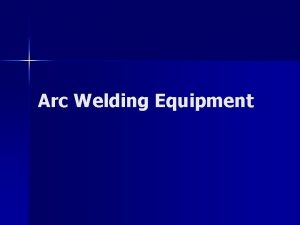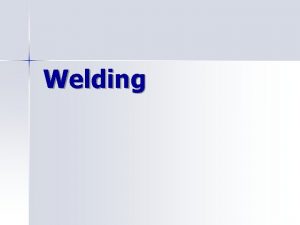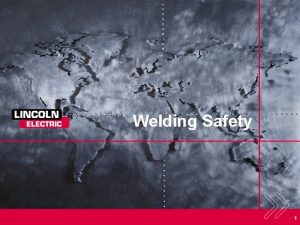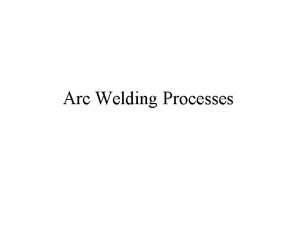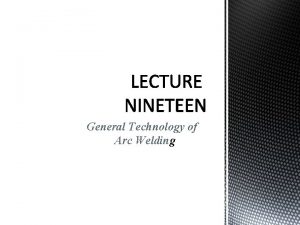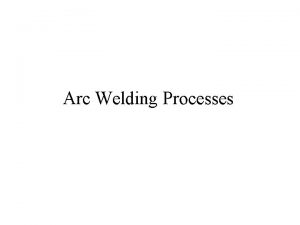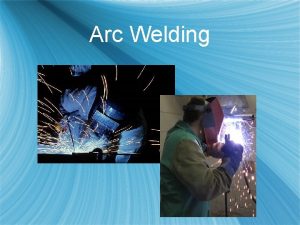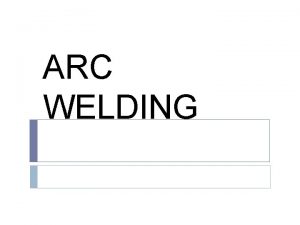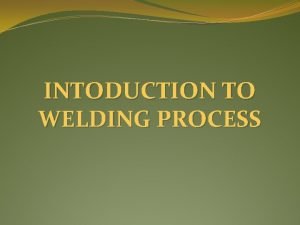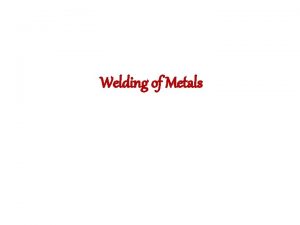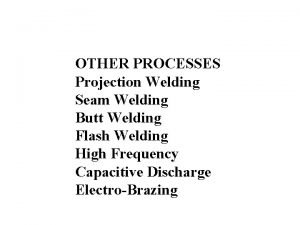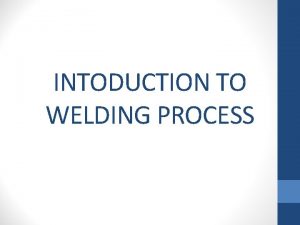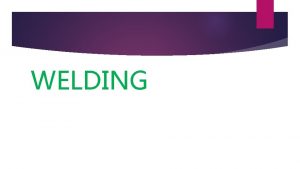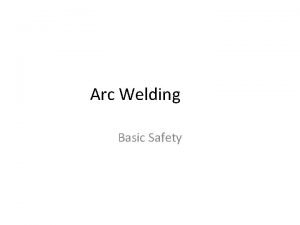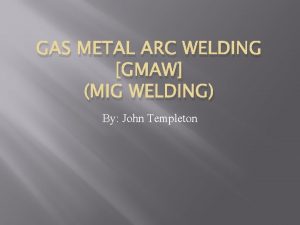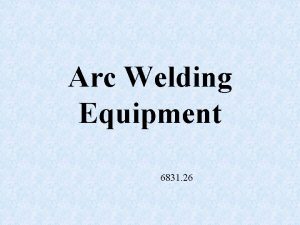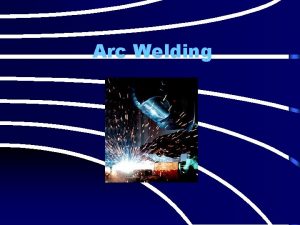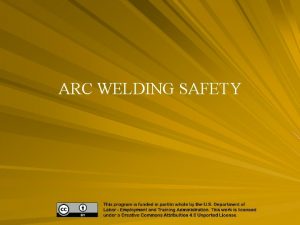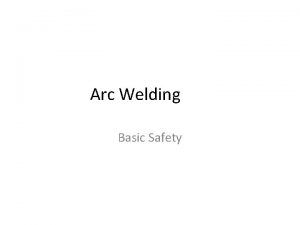Welding LEMMONS Arc Welding fusing two or more






























- Slides: 30

Welding LEMMONS

Arc Welding – fusing two or more pieces of metal together using heat from an electric arc Advantages of Arc Welding • Quick repairs • Cheap to operate • Arc welder has other uses(cutting, gouging, beveling)

Types of Welding Machines I. ARC WELDER A. AC Welder • SMAW(Shielded Metal Arc Welding) • Plugs into any 240 volt outlet • Uses AC current • Runs up to 225 amps

1. Advantages – Low cost – Easy to maintain Flow – 50% heat at electrode – 50 % heat at work

B. DC Reverse Current (DC+) • Deeper penetration • Higher possible amps

• 2/3 rd heat at work • 1/3 rd heat at electrode C. DC Straight Current (DC-) • Shallow penetration • Lower amps • Flatter bead • 2/3 rd heat at electrode • 1/3 rd heat at work

AC/DC Welders • Combines all three processes into one machine Gasoline Driven Machines

• AC/DC welding machine powered by a gas or diesel engine • Portable • AC generator power to run other tools II. MIG(Metallic Inert Gas)

1. Other names • hardwire, short arc, GMAW(Gas Metal Arc Welding), wire machine * Advantages • Can be used as an automatic welder • Can use flux core wire to eliminate gas • No slag • Continuous weld

III. TIG(Tungsten Inert Gas)

1. Other Names • GTAW(Gas Tungsten Arc Welding) Heliarc * Advantages • • • Welds are free of slag Produces the strongest weld No splatter Almost all metals can be welded with the TIG process Produce non corrosive welds

Selecting a Welder * Factors to consider: • Cost • Use • Select a reliable manufacturer (Lincoln, Miller, ESAB) • Guarantee or warranty (90 Days, 1 yr, etc. ) • Service

* Other equipment needed • Welding hood • Assure proper electrical hookup • Pliers • Leather gloves • Chipping hammer • Wire brush • Grinder • Metal Table

Electrodes A. Definition wire, either bare or with flux, used in the welding process B. Types of Electrodes 1. Coated – electrode metal should match base metal. Covered with powder flux.

2. Bare- requires excessive heat and is voltage sensitive. It is smoke free. 3. Carbon – special purpose rod for high carbon steel C. Electrode Classification 1. Universal color code and number system

Example: E 7018 E - electrode 70 - tensile strength in thousands pounds 1 } welding position 1 = all position 2 = flat and horizontal 3 = flat only

Example: E 7018 8 }current, penetration, flux, etc. numbers range 0 - 8 D. Electrode Size is determined by the diameter of the bare end of the electrode

Examples: 3/32” electrode • 36 rods per pound • Run at 30 -80 amps 1/8” electrode • 17 rods per pound • run at 70 -120 amps 5/32” electrode • 11 rods per pound • Run at 120 -170 amps

E. Common Electrodes 6010 – mild steel, DC+ deep penetration 6011 – same as 6010, AC/DC 6013 – AC/DC, quiet, general purpose 7018 – AC/DC+, high carbon steel, iron powder flux

Selecting an Electrode • • ID of base metal Available current Metal thickness Joint design Welding position Environmental conditions Storage Building Code

8 Essentials to a Proper Weld • • Proper electrode Metal preparation Proper amperage Proper electrode angle Proper arc length Correct travel speed Proper curing of finished weld Good connected ground

I. Preparing Metal for Welding a. Metal should be cleaned b. Dirty metal is harder to weld and requires more heat c. Clean metal by brushing, filing, sanding, grinding, scraping, sandblasting, chemically

d. Metal more than ¼” thick metal should be beveled at 30 degrees and spaced 1/16” apart e. Bevels – one-sided, two-sided, lap, corner

II. Amperage a. Too high • Flat bead • Splatter on bead edge • Undercut edges • Extremely loud b. Too low • high, narrow bead • Weak penetration • Hard to keep arc going c. Correct • Even, steady sound • Adequate penetration • Uniform in shape

III. Electrode Angle A. Flat welds – electrode angle should be 15 degrees to the direction of travel and 90 degrees to each side B. Vertical welds – electrode angle should be on the centerline and angled 30 degrees down

IV. Arc Length • The distance between the electrode and work • Arc length should equal the diameter of the bare end of the electrode

V. Travel Speed • How fast or slow the electrode moves across the work • The bead should remain the same width and height at all times • Watch the molten puddle to gauge travel speed

Methods of Starting an Arc 1. Scratching - simply drag the electrode across the work, lifting it when arc starts 2. Tapping – tap the electrode to the work, picking it up quickly while maintaining the arc

Causes of difficulty starting an arc 1. 2. 3. 4. Flux chipped off end of electrode Flux covering end of electrode Improper amperage(too low) Inadequate ground

Electrode movement or patterns 1. 2. 3. 4. 5. Slight arch Straight Circular Zig Zag Horseshoe
 Lirik lagu more more more we praise you
Lirik lagu more more more we praise you More more more i want more more more more we praise you
More more more i want more more more more we praise you Arc promoteur vs arc investigateur
Arc promoteur vs arc investigateur Mentoring circle
Mentoring circle A minor arc is
A minor arc is Arc emu88 com arc info 08 100008 html
Arc emu88 com arc info 08 100008 html Definition of shielded metal arc welding
Definition of shielded metal arc welding Smaw voltage
Smaw voltage Smaw unit
Smaw unit Introduction to smaw
Introduction to smaw Tig (tungsten inert gas)
Tig (tungsten inert gas) Chill plate welding definition
Chill plate welding definition Welding chapter 3 answers
Welding chapter 3 answers How can fca welding guns be cooled
How can fca welding guns be cooled History of arc welding
History of arc welding Stringer bead technique welding
Stringer bead technique welding Electrode specification
Electrode specification Ptaw welding
Ptaw welding Fcaw definition
Fcaw definition Bullet shaped ripples welding definition
Bullet shaped ripples welding definition Chapter 6 advanced shielded metal arc welding
Chapter 6 advanced shielded metal arc welding Fca welding practice plates thicker than 1/2 inch ____.
Fca welding practice plates thicker than 1/2 inch ____. Objectives of welding
Objectives of welding Fill freeze electrode
Fill freeze electrode Las busur gas
Las busur gas Joan of arc map
Joan of arc map Arc welding objectives
Arc welding objectives Chapter 3 shielded metal arc welding
Chapter 3 shielded metal arc welding Welding safety quiz
Welding safety quiz Flux cored arc welding advantages and disadvantages
Flux cored arc welding advantages and disadvantages Paw welding process
Paw welding process






